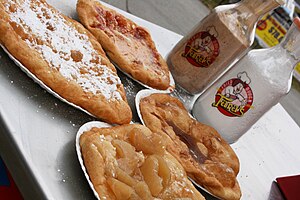Fried dough

Various fried dough toppings
|
|
| Alternative names |
fry dough fry bread fried bread doughboys elephant ears scones flying saucers buñuelos pizza fritte beaver tails |
|---|---|
| Course | Breakfast, dessert, or snack |
| Place of origin | Canada |
| Serving temperature | Warm |
| Main ingredients | Yeast dough |
| Variations | zeppole and others |
| |
|
Fried dough is a North American food associated with outdoor food stands in carnivals, amusement parks, fairs, rodeos, and seaside resorts (though it can be made at home). Fried dough is the specific name for a particular variety of fried bread made of a yeast dough; see the accompanying images for an example of use on carnival-booth signs. Fried dough is also known as fry dough, fry bread, fried bread, doughboys, elephant ears, scones, pizza fritte, frying saucers, and buñuelos (in the case of smaller pieces). These foods are virtually identical to each other, and recognizably different from other fried dough foods such as doughnuts, beignets, or fritters.
In Canada, pieces of fried dough are sometimes called beaver tails. According to Bill Castleman, a writer of books on Canadian word origins, the name referred to quick-baked dough "especially in early 19th-century places where people might camp for one night and where there was no frying pan." In 1978, Pam & Grant Hooker of Ottawa, Ontario founded the BeaverTails chain of restaurants specializing in the sale of fried dough pastries which are hand stretched to the shape of a beaver's tail.
In Newfoundland, a province in Eastern Canada, fried dough is referred to as a "Touton". A touton /ˈtaʊtən is produced by frying bread dough on a pan with butter or the leftover fat from "scrunchions" (fried preserved pork) and served with dark molasses, maple syrup, or corn syrup. It is traditionally made from leftover bread dough and pan-fried, as opposed to deep-fried.
...
Wikipedia
